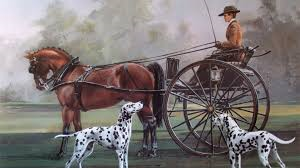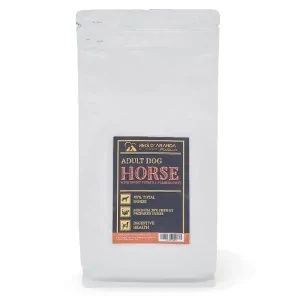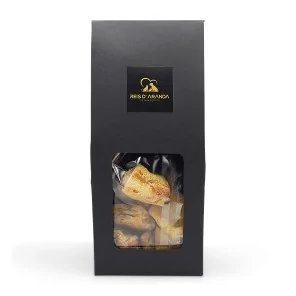The Tornjak originated from genetically homogeneous, almost extinct, indigenous shepherd dogs. These dogs have...
THE DALMATIAN
INTRODUCTION
The Dalmatian is an elegant, medium sized dog with a slender, muscular body; they are well known for their unique characteristics which make them easily recognisable, and if they are identified by anything it is by their white coat with black markings, as this is their most outstanding characteristic.
THE HISTORY OF THE DALMATIAN
The spotted dog has been a close companion of man, due to its usefulness and appearance. Already in Egyptian paintings we find what could be the ancestors of the Dalmatian: a medium-sized dog with black spots following the chariots. The Bewick Quadrupeds illustrated a Dalmatian serving as a guard dog with its appropriate bronze collar with padlock and fashionable cropped ears.
The earliest official evidence we have of the existence of the Dalmatian breed is in paintings and frescoes in Croatia, Dalmatia region, in the early 17th century. Although there is no clear consensus on the origin of the Dalmatian, in the absence of further evidence, the Fédération Cynologique Internationale (FCI) relies on these to give the origin of this breed.
We are talking about the paintings of the altar ‘Mary with Jesus and the Angels’ in the church ‘Gospa od andjela’ in the town of Veli Losinj, Island of Losinj in Croatia; dating from 1600 - 1630 AD.
Regardless of the fact that the name Dalmatian may come from the region of Dalmatia, it is a fact that, in the Catholic ceremonies of that place and at that time, it was customary to wear beautiful robes: the Dalmatian, a festive garment and considered a symbol of joy. These were worn by the deacon (representative of the church) to officiate at ceremonies, which made the moment of celebration more beautiful and emotional. Like the Dalmatian's mantle, it makes him more exotic, distinctive and elegant.

However, it was at the end of the 17th century that it gained popularity as a ‘coach dog’. Used by the English upper class in noble times. His athletic physique, balanced character, astute intelligence, protective instinct and exotic beauty made the Dalmatian the perfect companion dog for the carriages of the time. Able to keep pace with the horses pulling the carriages, for long journeys and long periods of time. Its endurance enabled it to stay in front as they moved forward, as well as prowling around and following small scent trails along the way.
It is believed that the Dalmatian's use as a companion dog had a double function: to alert of possible threats and therefore protect the horses from attacks by wild dogs; and not least, to bring elegance and beauty to the carriages of nobles.
(Information from ‘Flamenco de Lunares’)
THE STANDARD OF THE DALMATIAN
GENERAL APPEARANCE: Mesocephalic. Prism-shaped head with pendant ears. The body is rectangular, strong, muscular and particularly mottled. Movement should be elegant. Sex differences should be visible.
IMPORTANT PROPORTIONS:
BODY LENGTH: Height at withers = 10:9.
HEIGHT AT THE ARTICULATION OF THE ELBOW: 50 % of the height at the withers.
HEIGHT OF HIP: 20-25% of the height at the withers.
HEAD LENGTH : approximately 40 % of the height at the withers.
HEAD LENGTH : length of muzzle = 1:1.
HEAD: The head should be in proportion and harmony with the rest of the body and should not be too broad in the skull area. The length from the occipital protuberance to the stop and from the stop to the tip of the nose is equal 1:1. The muzzle may be slightly shorter. The topline of the skull and the topline of the muzzle are slightly divergent. The musculature and the cheek bones should not be too developed. The head should be totally free from wrinkles.
CRANIAL REGION:
SKULL: Flat, with a slight lateral rounding. Broadest between the ears and well defined temporal bone. Slight frontal furrow.
STOP: Moderately defined.
FACIAL REGION:
TRUFFLE: Long, nostrils well open, should be fully pigmented. Colour should be in accordance with the colour of the markings.
HOCIO: Well developed & strong jaw bones. Straight bridge of nose.
LIPS: Strong, well fitting to the jaws, never pendulous or too thick, without overly defined corners of lips. Full pigmentation is desired.
TEETH / TEETH: Scissor bite, i.e. the 6 upper incisors closely overlapping the lower incisors all set vertically in the jaw. A complete bite is desired, (42 teeth), according to the dental formula. The teeth are even and white. Pincer bite is tolerated in older dogs.
EYES: Oval, set in a sub frontal position at an angle of 10-15°. Eye colour according to the colour of the markings. The rims of the eyelids should be close fitting to the eyeball and should not be loose. Edge of eyelids fully pigmented according to coat colour.
EAR: Set on rather high, carried close to the side of the head. The length reaches to the inner corner of the eye or to the stop. The tips are slightly rounded. The ears are in the shape of an isosceles triangle. They are fine in texture and soft to the touch. It is very important that the ears are mottled, i.e. the ears should not be completely black or brown but mottled black or brown, the colour according to the colour variety, on a white base.
NECK: The neck should be strong and moderately long, tapering towards the head and free from dewlap.
BODY: Rectangular. The proportion of length of body to height at withers is 10:9.
CROSS: Well defined.
BACK: Powerful, straight.
LOIN: Short and muscular.
Croup: Muscular, sloping less than 30°.
CHEST: Deep and capacious, not too broad or barrel shaped. Depth of chest should be 45-50% of height at withers. Elbow height 50% of height at withers. Ribs well sprung.
BOTTOM LINE AND BELLY: Belly moderately tucked up but not tucked up.
TAIL: Set on following the croup. Reaches approximately to the hock or slightly longer. Strong at the base tapering evenly towards the tip; not too thick but in proportion to the body. Sabre shaped carriage. Preferably mottled.
LIMBS
FORELEGS:
GENERAL APPEARANCE: The forelegs should be in proportion to the rectangular body.
Shoulders: The angulation is approximately 115-120°.
ELBOWS: Close to the body.
FOREARMS: Bones developed in proportion to the body, strong (round). Forelegs set straight and limbs vertical.
Pasterns: Strong, slightly sloping, springy.
HANDS: The toes are compact, typical of the so-called cat foot. Pads strong and elastic. Nails preferably pigmented.
HIND LIMBS:
GENERAL APPEARANCE: In proportion to the body. Muscles strong and well developed. Hind legs parallel.
THIGH : Muscular and strong.
KNEES: Strong and well developed. Knee angulation of 40° to the horizontal. Angulation of the hock: Strong.
METATARSUS: The length of the hock is approximately 20-25% of the height at the withers. The angle of the hock is approximately 130°.
FEET: The toes are compact, typical of the so-called cat foot. Pads resistant and elastic. Nails preferably pigmented.
GAIT / MOVEMENT: Movement rhythmic, elegant and smooth. Long stride and trot with good reach and strong drive. Seen from the front the limbs are parallel.
COAT
HAIR: Short, glossy, harsh and dense all over the body.
COLOUR: The ground colour is pure white. Black mottled variety with black patches, liver mottled variety with brown patches. The mottling should be symmetrical, located over the whole body, clearly defined without intermingling with the white ground colour. The size of the spots should preferably be even, with a diameter of 2-3 cm. In the brown variety the spotting is somewhat smaller, 2 cm. The spotting on the head and limbs should be proportionally smaller than on the rest of the body. It is desired that the tail also be mottled, with spots also proportionally smaller than on the rest of the body. Splashing on the body is not desired and should be penalised. The mottling should not intermingle, i.e. form large patches. Spots and large coloured areas are not desired. The flecking should be particularly noticeable on the ears.
SIZE AND WEIGHT:
HEIGHT AT WITHERS:
- Males: 56 - 62 cm.
- Bitches: 54 - 60 cm.
Dogs with excellent type and balance should not be penalized for being over the upper limit.
PERSONALITY: Dalmatians are outgoing and friendly, but if not exercised sufficiently, they can become hyperactive. Dalmatians are loyal and devoted and always want to please; they love company and clowning around. However, their energy and stamina can be too demanding a challenge for some owners. Dalmatians take at least two years to settle down, possibly longer.
FAULTS: Any departure from the foregoing points should be considered a fault and the seriousness with which the fault should be regarded should be in exact proportion to its degree and its effect upon the health and welfare of the dog and its ability to perform its traditional work.
DISQUALIFYING FAULTS:
- Aggressiveness or extreme shyness.
- Any dog showing clear signs of physical or behavioural abnormalities.
- Converging head lines.
- Absence of more than 6 premolars, absence of M3 should not be considered as a fault.
- Entropion, ectropion, gaze eyes, eyes of different colour (heterochromia), blue eyes, partially blue iris.
- Absence of pigmentation on the nose.
- Curled tail.
- Monocle (patch around one or both eyes) or patches elsewhere.
- Tricolour (black and brown mottling on the same dog) brindle mottling, lemon mottling, orange mottling, blue mottling and pure white without mottling.
- Wiry coat or long coat.
- Deaf.
N.B.:
- Male dogs should have two apparently normal testicles fully descended into the scrotum.
- Only functionally and clinically healthy dogs of typical breed conformation should be used for breeding.
THE HEALTH OF THE DALMATIAN
Normally genetic screening helps to rule out chronic problems or hereditary diseases, when acquiring a Dalmatian puppy the submission of parental health tests is essential, but the main and ‘almost’ compulsory test is the BAER.
- ELBOW DISPLASIA: Disease of the elbow joint, in which there are alterations in the front legs and the dog can hardly walk because of the pain and the functional alteration, which worsens with exercise. It usually occurs from 1 year of age onwards. It usually presents symptoms on both sides. The cause is hereditary.
- GLAUCOMA: Glaucoma in dogs, cats and other animals is a group of diseases that progressively and irreversibly damage the optic nerve, causing a decrease in vision. The optic nerve is a key structure. Through it, the images captured by the retina are transmitted to the brain (converted into nerve impulses) for interpretation and the generation of vision.
Aqueous humour is a fluid found inside the eye. A healthy eye permanently expels some of this fluid and replaces it with new fluid as it is generated. If the outflow pathways are obstructed, the excess fluid increases intraocular pressure, which can irreversibly damage the optic nerve.
- UROLITHIASIS: Symptoms include haematuria, difficulty urinating, vomiting, dull pain, and if aggravated, urinary retention and uraemia.
- CALCULUS: The Dalmatian is famous for the frequency with which he suffers from this disease. It is caused by the Dalmatian's inability to convert uric acid into allantoin. When stones are so large that they cannot be removed from the bladder, urethral obstruction occurs. If this condition is prolonged, failure to eliminate urine can lead to dilatation of the bladder - dilatation of the urethra - dilatation of the kidney - and loss of kidney function, ultimately leading to death.
- HIP DYSPLASIA: Hip dysplasia is a multigenic and osteoarticular disease that can be hereditary and degenerative. Therefore, there may be different factors with which to try to predict whether the disease can be developed or not. It is necessary to take into account that, although it can be a hereditary disease, it does not always have to develop as it is possible that the dog does not transmit it to its descendants.
- DEAFNESS: As specified in the breed standard, the Dalmatian is a dog prone to deafness for genetic reasons and issues. It is the most serious and widespread problem worldwide, and also the best known. The occurrence of deafness has been linked to variable low or weak pigmentation and the presence of blue eyes. It is important that, before acquiring a Dalmatian, the correct hearing of the parents is ensured by means of audiometric tests, commonly known as the BAER test. It is important to take into account the result of this test and to know the hearing threshold of our dog. A dog with correct hearing should be +/+ in the audiometric tests, which will show that the dog is hearing in both ears (bilateral hearing). If the results are +/- or -/+ it means that the dog has unilateral hearing, therefore he is deaf in one ear or the other. If the result is -/- it means that the dog is completely deaf. This result will not vary throughout the dog's life.
This test is always carried out by a veterinarian specialised in neurology when the puppy is approximately 6-7 weeks old, and guarantees the hearing of the dog and its possible descendants. It can also be done when the dog is an adult if it has not been done before, but in any case, it would not be appropriate to do it at this age if there is a motivation for breeding, as the result of the whole litter from which it comes should always be known if this purpose is recognised. The fact that the dog is hearing does not rule out the possibility that it carries deafness in its genetics. - ATOPIAS: The Dalmatian, like all white coated dogs, can show a predisposition to suffer from allergies and/or skin irritations due to the ‘weakness’ of the white coat in comparison with other colours. These reactions may be triggered by seasonal changes, exposure to a damp environment or direct contact with certain trees or plants which may or may not necessarily be in the process of pollination. Dally rash, or bacterial folliculitis, is a typical allergic inflammatory process in the breed that can generate these responses to the above scenarios, although it can also be a response to a stressor or state. Insect bites or certain ingredients in their food can also provoke reactions, although in the latter case it is much less common.
DALMATIAN HUA AND DALMATIAN LUA
A Dalmatian LUA stands for Low Uric Acid, therefore, LUA Dalmatians are specimens resulting from a ‘genetic modification’ to achieve the production of low levels of uric acid in their urine (or rather, normalised as in other dog breeds); therefore they have less chance of creating urate crystals in their kidneys, and therefore less risk of kidney stones forming and obstructing the urinary tract. What we commonly refer to as ‘kidney stones’.
Dalmatians are known for their uricotelic metabolism, i.e. in their urine they predominantly excrete uric acid as a waste product of nitrogen metabolism (all other mammals - including all other dog breeds - are ureotelic excreting predominantly urea). This, unfortunately, can lead to the formation of kidney and/or urinary stones, as a result of the accumulation of these urate crystals; especially in male dogs, where the urinary tract is narrower.
LUA Dalmatians are the result of a backcross project that began in 1973 with a cross between a healthy, champion Pointer named CH. Sandown of Rapid Transit, and a female Dalmatian called Lady Godiva.
Dr. Robert Schaible, a physician and geneticist at Indiana University, carried out the breeding in an attempt to eliminate the Dalmatian's genetic defect affecting uric acid metabolism. Registered Dalmatians were used in subsequent matings with the progeny of the original Dalmatian-Pointer cross. The first three matings, called ‘backcrosses’, produced progeny that were divided into half litters of LUA (low uric acid) Dalmatians and half litters of HUA (high uric acid) Dalmatians. When the fifth generation was reached, the American Kennel Club agreed to register one male and one female LUAs. HUA and LUA were initially distinguished by the difference in their samples, with up to ten times less uric acid found in creatinine in situ, as well as, initially, the pigmentation and staining, clearly less distinct and in less quantity. Today DNA analysis is performed to identify the specific gene found on chromosome 3, and the spotting of the Dalmatian LUA is almost as similar as that of the Dalmatian HUA.
Currently this project is at a very advanced generation stage since the original cross. The progeny have 99.8% of registered Dalmatian DNA, therefore these facts suggest that the LUA/HUA offspring are indistinguishable from traditional Dalmatians. LUA puppies have uric acid values ten times lower than their HUA littermates, and this phenotype remains in adulthood as demonstrated by ten of the LUA offspring tested to date, showing uric acid levels up to six times lower than HUA puppies in the bladder, tested by ultrasound by Dr Susanne Hughs.
CONCLUSION
If there is one thing the Dalmatian breed is known for, apart from its spotted characteristics, it is for being an intelligent and loyal dog. It is also an easy dog to train and very suitable for family life.
This breed of dog also has a particularly good memory and needs plenty of exercise to satisfy its energy requirements.
Leave a comment
Log in to post comments
















